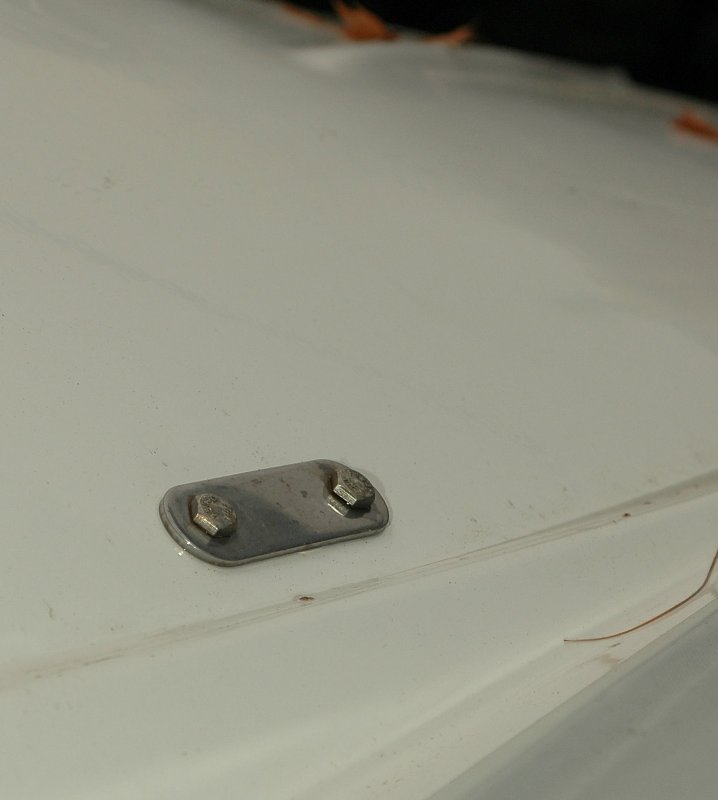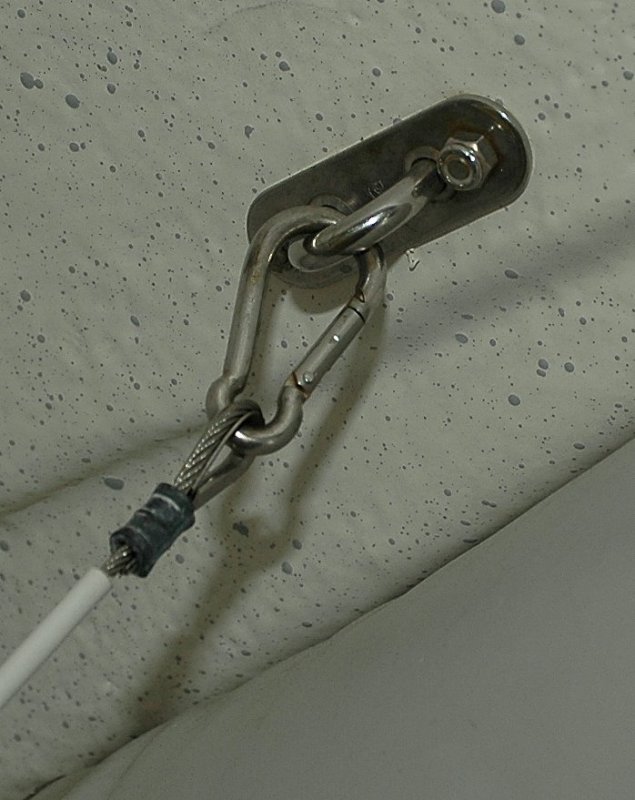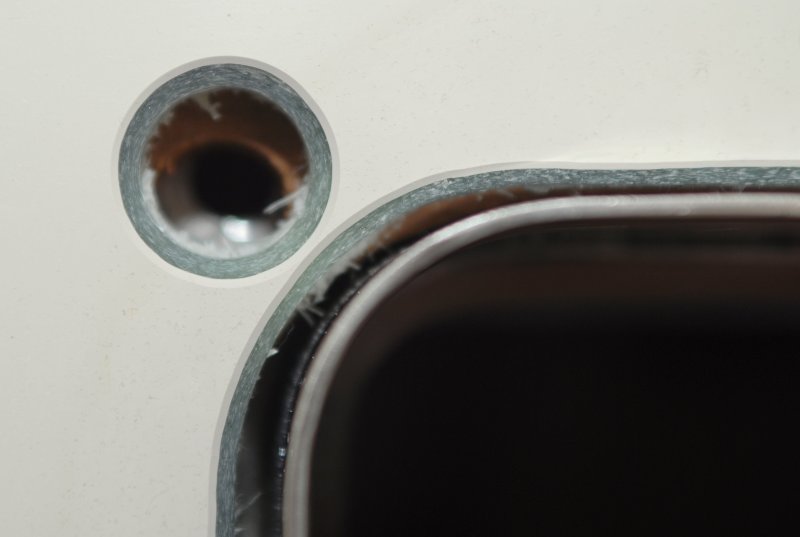Tim..
David Pascoe is a marine surveyor out of Florida who is quite right on a number of issues and quite wrong on many too. He is controversial to say the least.
A few points I disagree with him on are:
#1 Sealing the underside of the deck with sealant! Why? Common sense and history show us that crevice corrosion is real and if the water does not have anywhere to escape to it will rot the bolts and or migrate into an unsealed core. I notice he has no survey results for Hinckley's, Morris Yachts or Lyman Morse all of whom ONLY seal the deck side.
If you have sealed the core off by over drilling, and doing an epoxy plug, sealing both sides will certainly slow a leak to the inside but it does not guarantee the top side did not leak and that crevice corrosion is not prevalent in your stanchion bolts.
I for one would prefer a drip inside the boat to notify me it's time for re-bedding than to find out in rough seas that because I sealed the inside I am now watching as my boat sails off without me because that stanchion broke off due to crevice corrosion.
By sealing ONLY the deck side you will know when you have a leak and can attend to it before your bolts begin to corrode or your core gets soaked. NEVER, NEVER EVER seal both sides without first sealing off the core!!!!! Doing this will cause leak migration and the water will come out 15 feet from where the leak is so good luck finding it..
#2 Pascoe makes NO mention of what a proper bedding technique actually entails. He makes no mention of the "countersinking method" which in effect creates an o-ring around the bolt. He mostly just talks about no bedding at all and bashes the DIYer, as he likes to do, to promote business to his industry buddies and to scare owners away from doing their own repair.?? You want anti DIY scare tactics read his post on "moisture meters". Trust me they are NO WHERE near as complicated as he tries to scare you into believing..
#3 He makes no mention of "real" and substantial backing plates that would prevent movement, which leads to leaks, and says instead to use "washers" & 5200.
#4 He states that 5200 is an adhesive, no sh$t sherlock! What he refuses to acknowledge is that 5200 is nearly TWICE as adhesive as the bond your gelcoat has to the substrate. Why on earth would anyone need an adhesive, on a properly fastened and backed MECHANICAL fitting, that has nearly twice the bond of the gelcoat? It makes ZERO sense unless your trying to feed your boat yard buddies future gelcoat repair business...
#5 He makes no mention of the fact that a LARGE majority of boat builders, up until the early to mid 90's, used 5200 for bedding. So if 5200 is the miracle compound how is it we still have thousands, upon thousands of boats, bedded with 5200, with wet decks? I know of very few manufacturers who factory bedded with polysulfide. Why? Most likely because it was cheaper to use the same sealant for everything keels, deck to hull, bedding etc. and buying drums of 5200 was more economical than buying two drums (this was actually told to me by a boat builder).
#6 He actually makes the claim that 5200 is "highly effective" without mentioning any facts to back it up like the fact that close to 8 out of 10 used boats on the market has wet decks, to some extent, and a good majorty of them were factory bedded with 5200.
I have personally re-bedded well over 40 leaking 5200 sealed components including a keel on a Catalina 30. I've re-bedded many more components that leaked with 5200 than any other product perhaps due to it's wide spread use but I've had to re-bed polysulfide and silicone too. The 5200 on my keel ripped a large chunk of the laminate off the keel stub when it finally was cut far enough, with a Sawzall, to tear the remaining 6 inches, that had not been cut.
It is my experience that execution, preparation and technique are FAR more important than what sealant you use. As evidence, my 1979 CS-36 was bedded entirely using butyl (including the hull to deck joint). My hand rails, genny tracks, port lights and many other items were and are still leak free after 29 years with butyl! Butyl by the way NEVER HARDENS and has about 50-75 PSI of adhesion strength. 5200 gets harder and harder over the years and has 700 PSI of adhesion so what Pascoe says about adhesion is COMPLETE BUNK with a properly mounted, backed and sealed mechanical fitting. I've yet to see a 29 year old 5200 fitting that has not leaked. They may be out there but I've yet to see one...
For on deck fittings I like polysulfides (140 PSI) then Sikaflex 291 (221 PSI) and then 3M 4000 or 4200 both about 300 PSI. I also still use butyl tape on some things like hatches and ports and even genny tracks.
Over drilling/epoxy filling and a light counter sinking of the bolt hole is all that's needed to be leak free for a long time.
If you must use a polyurethane for deck fittings try Sikaflex 291.
Method:
The best method for bedding hard ware is to countersink each hole slightly on the deck side. Then apply your bedding compound/sealant and then tighten it all the way down! Reaming & potting the holes with epoxy takes it to the next level beyond this and insures no deck core damage..
By doing this you've created an o-ring or gasket completely surrounding the shaft of the bolt and the countersinking ensures the sealant does not squeeze out and actually forces more into the countersunk area the more you tighten. By waiting for it to cure then tightening you run a huge risk of twisting the bolt and BREAKING the seal!
The picture bellow shows a set of lifting pad eyes I installed on my RIB using the countersink method and 3M 101 (Pascoe would NOT be proud = low adhesion). These pad eyes are BELLOW the waterline and are used to lift the dinghy into the davits. They have been bone dry and never once leaked a drop of water in the five years since I installed them. This method works bellow the waterline and on deck too...
DO NOT wait to tighten and creating a "gasket"! I'm convinced this method was created by boatyards to ensure future business...
Outside the hull backing plate:
Inside the hull lifting eye. Five years and not so much as a rust stain! There is NO leaking:
Here's a photo of the countersinking and beveling I did when installing new ports. That reveal is about 1/16 of an inch:




